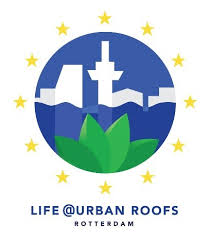
Urban Roofs – LIFE@Urban Roofs – stimulating private investment in climate adaptation – who’s afraid of red, yellow, green and blue
Good Practices Category
Good Practices Summary
Promotion of multifunctional roofs. The use of multifunctional roofs that have greater benefits for property owners than traditional green roofs. These roofs combine several types of infrastructure: green (to reduce the urban heat island effect and support biodiversity), blue (water storage), yellow (energy generation) and red (social use).
The challenge within this project is to convince private building owners to invest in such roofs. But green and blue roofs are not necessarily financially attractive. By developing multifunctional roofs: combinations of green, blue, yellow (energy generation) and red (economic functions like a rooftop bar), the attractiveness can be improved. Investors like housing corporations or other social institutions have non-financial goals as well.
Mitigation
Cities are vulnerable to flooding after extreme rainfall and to heat island effects. Effective adaptation measures are necessary to make cities more resilient to climate change. The project will trial the use of multifunctional roofs that have greater benefits for property owners than traditional green roofs. Including roofs and facades in climate adaptation strategies can be an effective way of circumventing the first problem. Roofs on houses, office buildings, hospitals and schools can be used for green infrastructure or water storage.
Replicability/Knowledge Transfer
The effects of the adaptation measures will be monitored. Data will be used to evaluate and validate the demonstration cases. This will lead to the development of a transferrable and replicable blueprint of the approach to stimulate private investment. As part of the LIFE project, Vejle in Denmark will be the first to replicate the approach. It will intensively cooperate with Rotterdam to provide solid evidence of the validity and efficacy of the approach.
Resources
Rotterdam has selected three demonstration sites to maximise the climate and publicity impact:
- The Peperklip, a large, lower-income housing project requiring large-scale measures;
- De Heuvel, a community building in the city centre that is used by everyone from business executives to primary school children; and
- Robert Fruinstraat, a street with a range of property types, where the owners face a common problem from flooding.
As part of the project, an experimental roof is installed. They will test innovations in the field of multifunctional rooftop use. Suppliers can use the roof to research and demonstrate. Furthermore, a design contest will stimulate building owners and designers to develop a plan for a multifunctional rooftop and, eventually, install the designed plan.
Target Audience
Policy Implications
LIFE@Urban Roofs will encourage real estate developers and building owners to invest in climate change adaptation. This new approach will see the local government acting as a stimulator and facilitator.
Moreover, the project falls within the scope of EU and national policies to mitigate the effects of climate change and the Rotterdam Climate Initiative, which has the ambition to have a clean, green and healthy city where sustainability contributes to a strong economy.
Social Dimension
A more profitable business case can be developed for entrepreneurs by combining various functions on rooftops. Citizens can benefit from multifunctional roofs because of their added value in liveability.
The benefits of multifunctional roofs are not always clear. Not all benefits can be directly valued in money terms and not all benefits are directly visible to all users and the payers. In the project a social cost benefit analyses is developed that maps the financial and social aspects. These social costs and benefits, in addition to the financial costs and benefits, are made transparent using the calculation tool developed but the project.
Innovation Type
Awareness, Process, TechnologyInnovation
To boost innovation, the project will provide roof space for experimental technologies, and will organise a design contest for multifunctional roofs. Currently, they differentiate four colours/ functions:
- Green roofs include vegatation, thus provide greening and biodiversity in the city.
- Blue roofs retain rainwater and provide delayed drainage. They are specially designed to store and/or buffer as much water as possible. This can be done in combination with vegetation, such as on green roofs, or by building temporary rainwater storage.
- Yellow roofs generate sustainable energy, for example by using solar panels, windmills and / or solar boilers.
- Red roofs provide social functions, tackle lack of space and enhance social cohesion. They have space for recreation (terrace, a sports field or a swimming pool. Ideal for efficient and effective use of living space in a busy city).
Outcome/Barriers
In the urban environment, there is little space at ground level to tackle climate and water related issues. At the same time, a large amount of roof space in the city is unused. Roofs offer all kind of opportunities for use, and can make an important contribution to the quality of life and the quality of life in the city. They can therefore be seen as an extension of the use area in the city
The municipality of Rotterdam has been a front runner on green roofs for years. At the current moment over 360,000 square meter of green roofs have been installed in the city. Furthermore some 75,000 square meter of solar panels have been installed on rooftops as well. Gradually a change is taking place from green roofs towards multifunctional rooftop use.

